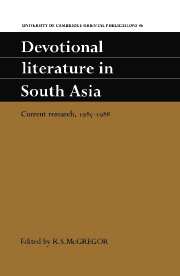![]()
Sadguru and the Holy Spirit

"You may say that the God of gods gives grace through the brahman: then why should one require a Sadguru? I answer, truly, that there is no attaining to the real treasure without a Sadguru. (5. 1. 19) Therefore the one who desires salvation must have a Sadguru; without a Sadguru none has achieved salvation; this will not happen until the end of ages. (5. 1. 44)...”
Sadguru and the Holy Spirit
Christopher Shelke, Sj
"Sant Ramdaa (1608-81), a Maharashtrian mystic akin to the Varkari movement of Pandharpur, not only influenced Sivaji, the founder of the Maratha kingdom, but gave spiritual and moral vigour to the thousands of Marathas who helped Sivaji to establish Hindu self-rule (svarajya). Ramdas has considerable influence even today on the social and political life in Maharashtra. In this paper I shall examine the concept of the Sadguru (divine guru) in his compositions, and I would like to point out how this concept is close to that of the Holy Spirit that dwells in the heart of men. Therefore I will make some references to the spiritual growth of Ramdas, as well as to some Christian mystics.
Ramdas' teaching about the Gurus.
In the Das-bodh (in the fourth samas of the first dasak), Ramdas praises the Sadguru. According to Ramdas, the Sadguru pervades the universe;... The Sadguru is greater than the touchstone (paris), the wishing tree, or the wishing cow. Ramdas bestows such great praises on the Guru because the latter imparts real knowledge to the disciples and teaches him the way of right behaviour.
Ramdas accepts traditional doctrine about the guru. According to this the brahman is guru to all castes because it was his duty to teach the Vedas and religion (dharma) to all others: 'The brahman is a guru to all, even if he becomes actionless. One must always surrender one to him with complete submission.
'This is an acceptance not merely of traditional Vedic doctrine on the part of Ramdas but also of the ritualistic worship performed by a brahman as a pujari, and therefore Ramdas says that words uttered by a brahman can make even a casteless person a brahman. The âctionless' brahman cannot give brahmadnyan (brahmajnana), true knowledge. For the attainment of this one requires the Sadguru; without the Sadguru there is no possibility of salvation.
You may say that the God of gods gives grace through the brahman: then why should one require a Sadguru? I answer, truly, that there is no attaining to the real treasure without a Sadguru. (5. 1. 19)
Therefore the one who desires salvation must have a Sadguru; without a Sadguru none has achieved salvation; this will not happen until the end of ages. (5. 1. 44)...
Functions of a sadguru
Ramdas narrates various functions of a sadguru (earthly guru). The sadguru unites the devotee with God; he frees him from the troubles and pains of samsara (life and the world); by giving knowledge he liberates the disciple from the bondage of wishes and offers him the knowledge of things and their nature; further he explains his teaching, and advises abstinence. Thus he destroys avidya, ignorance, in the disciple. At the end of his explanation about the guru, Ramdas reduces all these functions to one: the real guru proposes the knowledge of the self and of God. The one who has achieved atmajnana also achieves brahmajnana (i.e. 'knowledge of the Highest'). Through the achievement of atmajnana one realises God and achieves unity with him: 'Listen to the characteristics of jnana: jnana means atmajnana, to see oneself by self, yes, this is real knowledge. To realize the God of gods, to acknowledge the true nature, to ask about the eternal and passing: this is knowledge' (5. 6. 1-2).
Atmajnana
The realisation of atmajnana by a person is simultaneously the realisation of brahman. It is an experience of the assertion aham brahmasmi. The devotee comes to the realisation that he is no different from the infinite brahman. However, this realisation comes at a moment when the devotee (jivatma) is still existing by itself. This is the ultimate existential experience of finiteness and infinitude, of the reality of both self and the infinite brahman...
The soul can achieve such knowledge because the Sadguru dwells in its heart, but not by study of the scriptures nor of any other book. This is possible only by recognising the self (5. 6. 19). Suddhajnana means realisation of the self by the self: it is a process of going into the self.”
R. S. McGregor, Devotional Literature in South Asia: Current Research, 1985-1988,
Cambridge University Press, 1992, pp. 153-54
Disclaimer: Our material may be copied, printed and distributed by referring to this site. This site also contains copyrighted material the use of which has not always been specifically authorized by the copyright owner. We are making such material available to our readers under the education and research provisions of "fair use" in an effort to advance freedom of inquiry for a better understanding of religious, spiritual and inter-faith issues. The material on this site is distributed without profit. If you wish to use copyrighted material for purposes other than “fair use” you must request permission from the copyright owner.